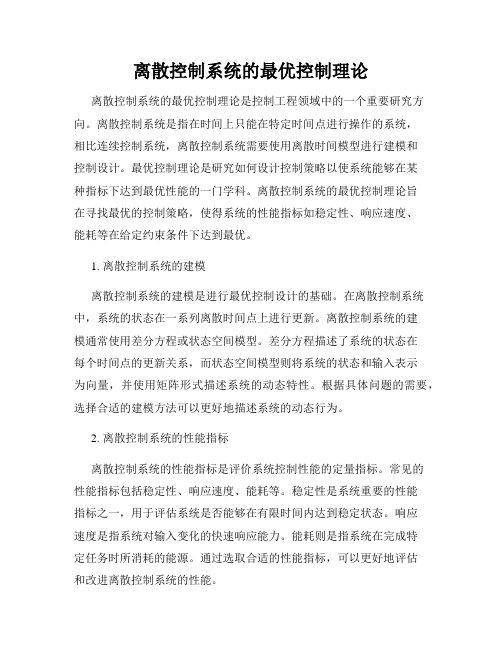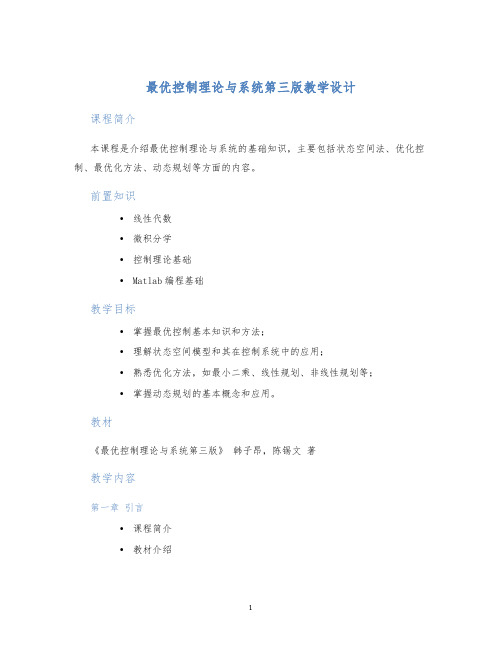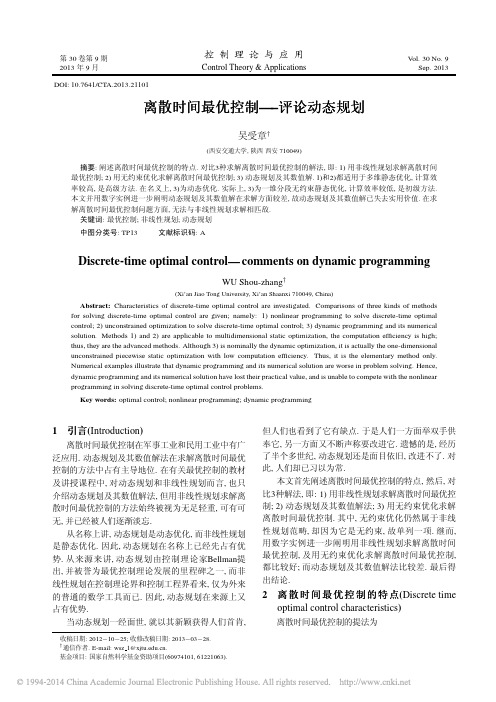第5章 离散时间系统最优控制
离散控制系统的最优控制理论

离散控制系统的最优控制理论离散控制系统的最优控制理论是控制工程领域中的一个重要研究方向。
离散控制系统是指在时间上只能在特定时间点进行操作的系统,相比连续控制系统,离散控制系统需要使用离散时间模型进行建模和控制设计。
最优控制理论是研究如何设计控制策略以使系统能够在某种指标下达到最优性能的一门学科。
离散控制系统的最优控制理论旨在寻找最优的控制策略,使得系统的性能指标如稳定性、响应速度、能耗等在给定约束条件下达到最优。
1. 离散控制系统的建模离散控制系统的建模是进行最优控制设计的基础。
在离散控制系统中,系统的状态在一系列离散时间点上进行更新。
离散控制系统的建模通常使用差分方程或状态空间模型。
差分方程描述了系统的状态在每个时间点的更新关系,而状态空间模型则将系统的状态和输入表示为向量,并使用矩阵形式描述系统的动态特性。
根据具体问题的需要,选择合适的建模方法可以更好地描述系统的动态行为。
2. 离散控制系统的性能指标离散控制系统的性能指标是评价系统控制性能的定量指标。
常见的性能指标包括稳定性、响应速度、能耗等。
稳定性是系统重要的性能指标之一,用于评估系统是否能够在有限时间内达到稳定状态。
响应速度是指系统对输入变化的快速响应能力。
能耗则是指系统在完成特定任务时所消耗的能源。
通过选取合适的性能指标,可以更好地评估和改进离散控制系统的性能。
3. 最优控制理论的基本原理最优控制理论的基本原理是寻找一组最优控制策略,使得系统的性能指标达到最优。
最优控制问题通常可以通过数学方法建立为一个优化问题。
其中,最常见的方法是最小化或最大化一个性能指标的数学表达式。
为了求解这些优化问题,可以使用动态规划、最优化理论等数学工具。
最优控制理论提供了一种系统优化设计的方法,可以帮助工程师设计更优秀的控制策略。
4. 最优控制策略的设计方法最优控制策略的设计方法取决于具体的离散控制系统和性能指标。
常见的设计方法包括经典控制方法和现代控制方法。
最优控制5

J [u(t )] [ x(t f ), t f ] L[ x(t ), u(t ), t ]dt
t0
(5 13)
第5章
x
J [u(t )] [ x(t f ), t f ] L[ x(t ), u(t ), t ]dt
t0
tf
(5 13)
(5 14)
xt f x1 x0
u (0)
根据状态方程
x(1) 2 x(0) u(0)
3 J *[ x(0)] min{x 2 (0) u 2 (0) 3[2 x(0) u (0)] 2 } u * (0) x(0) u (0) 2
最后,从前往后推,可得出最优控制序列u*(0),u*(1),u*(2) 关于动态规划本质的讨论: 一个最优控制策略具有这样的性质,不论过去的状态及过去的决策如 何,如把现在的状态看作后续状态的初态,则其后诸决策仍必须构成一 最优策略。
J *[ x(t ), t ] J * J * * H ( x, , t ) min{H ( x, , u, t )} uU t x x
哈密尔顿——雅可比——贝尔曼方程 定义:
(5 22)
(5 24)
第5章
J *[ x(t ), t ] J * J * * H ( x, , t ) min{H ( x, , u, t )} uU t x x
解法一:穷举法,列出所有可能的组合方案,找出时间最短的一个
可能的行车线路共有:2*2*2=8 (每阶段有两种可能)
缺点:计算量大,容易出错。
第5章
解法二:动态规划法,从终点开始,按时间最短为目标,逐段向前逆推, 依次计算出各站至终点站的时间最优值,据此决策出每一站的最 优路线。
离散控制系统中的优化控制算法

离散控制系统中的优化控制算法离散控制系统是指由离散时间信号构成的控制系统,其输入、输出和各环节变量的取值都是离散的。
离散控制系统广泛应用于自动化领域,涵盖了许多实际问题的解决方案。
而在离散控制系统中,优化控制算法被广泛研究和应用,以提高系统性能和降低能耗。
1. 离散控制系统简介离散控制系统是指系统中各变量值随时间按照离散时间点变化的控制系统。
离散控制系统可以通过采样和量化来实现,通常用数字信号处理器(DSP)来处理和控制。
离散控制系统有着广泛的应用,比如电力系统、通信系统、工业自动化等。
离散控制系统的任务是根据系统状态和性能指标,通过对输入信号的调节,使系统输出满足预期要求。
2. 优化控制算法优化控制算法是离散控制系统中常用的一种算法,旨在通过优化系统的控制策略,使系统性能达到最优。
优化控制算法包括多种方法,如最优化算法、遗传算法、模拟退火算法等。
这些算法可以针对不同的系统和问题进行优化设计,以达到更高的性能指标和更低的系统能耗。
3. 最优化算法最优化算法是优化控制算法中最常用的一种。
最优化算法通过寻找目标函数的最小值或最大值来确定最优控制策略。
最优化算法包括梯度下降法、牛顿法、共轭梯度法等。
在离散控制系统中,最优化算法可以应用于参数优化、系统建模和预测控制等方面。
4. 遗传算法遗传算法是一种模拟自然界进化过程的优化控制算法。
遗传算法通过模拟自然选择、交叉和变异等操作,对系统进行优化和搜索。
遗传算法在组合优化、参数优化等问题中有着广泛的应用,可以有效地搜索大规模的解空间。
5. 模拟退火算法模拟退火算法是一种基于物理退火原理的优化算法。
模拟退火算法通过模拟原子在固体中退火的过程,对系统进行随机搜索和优化。
模拟退火算法在系统参数优化、系统调度等问题中被广泛使用。
6. 应用举例在离散控制系统中,优化控制算法可以应用于许多实际问题的解决。
比如在电力系统中,通过优化发电机组的负荷分配,可以提高系统的能源利用率和稳定性;在通信系统中,通过优化调度算法,可以提高信道利用率和传输速率;在工业自动化领域,通过优化控制算法,可以提高生产效率和产品质量。
离散控制系统中的最优控制方法

离散控制系统中的最优控制方法离散控制系统是一种在时间和状态上都是离散的控制系统,相对于连续控制系统来说,其最优控制方法也有所不同。
本文将介绍离散控制系统中的最优控制方法,主要包括动态规划、最优化算法和强化学习。
一、动态规划动态规划是一种基于状态转移的最优化方法,在离散控制系统中有着广泛的应用。
其基本思想是将原问题分解为若干子问题,并通过求解子问题的最优解来得到原问题的最优解。
在离散控制系统中,我们可以将状态和控制变量转化为状态转移方程,然后利用动态规划递推求解,得到最优的控制策略。
二、最优化算法最优化算法是一种通过迭代优化来求解最优控制问题的方法,常见的有梯度下降法、牛顿法等。
在离散控制系统中,我们可以将控制问题转化为一个优化问题,并使用最优化算法来求解最优的控制策略。
例如,在离散时间马尔可夫决策过程中,我们可以利用值迭代或策略迭代等最优化算法来求解最优策略。
三、强化学习强化学习是一种通过试错学习来求解最优控制问题的方法,其核心思想是智能体通过与环境的交互来学习最优的行为策略。
在离散控制系统中,我们可以将控制问题抽象为一个马尔可夫决策过程,并使用强化学习算法如Q-learning、SARSA等来求解最优策略。
强化学习在离散控制系统中具有较好的应用效果,在复杂的离散控制系统中能够找到近似最优的控制策略。
综上所述,离散控制系统中的最优控制方法包括动态规划、最优化算法和强化学习。
这些方法在不同的离散控制系统中有着广泛的应用,能够求解出最优的控制策略。
在实际应用中,我们需要根据具体的控制问题选择合适的方法,并结合系统的特点和需求进行调整和优化。
离散控制系统中的最优控制方法在提高系统性能和效率方面具有重要意义,对于实际工程应用具有较大的价值。
5 离散时间系统最优控制

(5-2-9)
综上所述,离散Lagrange问题(5-2-1)的极值若存在,其极值解 x * ( k ) 必满足Euler方程
Lk L k 1 0 x ( k ) x ( k )
N 1 k 0
[ x(k ) x(k 1)] B u(k )
(5-1-5)
k 0
N 1
。则该多级萃取过程寻求收益最大化问题就可以描述为一个离 V 散最优控制问题,即要确定一组最优控制序列u(k)( k = 0,1,…, N-1),使性能
指标J达到最大。
(2) 离散系统最优控制问题的提法
给定离散系统状态方程
x ( k 1) f [ x ( k ), u( k ), k ], k 0,1, , N 1
和初始状态
(5-1-6) (5-1-7)
x (中x ( k ) R , u( k ) R 分别为状态向量和控制向量,f 为连续可微的n维
注意:是λ(k+1),不是λ(k)
则有
Lk ( k 1) x ( k ) Lk 1 (k ) x ( k )
(5-2-16) (5-2-17) (5-2-18) (5-2-19) (5-2-20) (5-2-21) (5-2-22) (5-2-23) (5-2-24)
9
考虑 J 中,
Lk
Lk 1
1 2 (5-2-14) u ( k ) ( k 1)[ x ( k ) au( k ) x ( k 1)] 2 1 u 2 ( k 1) ( k )[ x ( k 1) au( k 1) x ( k )] (5-2-15) 2
最优控制理论与系统第三版教学设计 (2)

最优控制理论与系统第三版教学设计课程简介本课程是介绍最优控制理论与系统的基础知识,主要包括状态空间法、优化控制、最优化方法、动态规划等方面的内容。
前置知识•线性代数•微积分学•控制理论基础•Matlab编程基础教学目标•掌握最优控制基本知识和方法;•理解状态空间模型和其在控制系统中的应用;•熟悉优化方法,如最小二乘、线性规划、非线性规划等;•掌握动态规划的基本概念和应用。
教材《最优控制理论与系统第三版》韩子昂,陈锡文著教学内容第一章引言•课程简介•教材介绍第二章状态空间法•模型描述–动态系统与状态方程–状态变量与状态空间•基本概念–可观性与可控性–稳定性判据第三章优化控制•范畴与概念•线性二次型调节器–离散时间系统–连续时间系统•数字计算算法第四章最优化方法•最小二乘问题•线性规划问题•非线性规划问题第五章动态规划•基本概念•离散时间动态规划–最优子结构–递推式的建立–递推法解决离散时间动态规划问题•连续时间动态规划第六章总结与测试•课程总结•测试与准备教学方法•课堂讲授:通过理论讲解,引导学生了解控制原理,在讲解过程中会有举例和计算操练。
•组织讨论:通过设计控制问题,组织学生进行讨论并解决实际问题。
•课外作业:课堂讲授之后,要求学生完成作业,加深对理论知识的理解和掌握。
考核方式•课堂测试:考察学生掌握情况,包括课堂讲解内容和作业题目。
•期末考试:考查学生对整个课程的掌握程度,考试形式为书面考试和机试。
参考文献•韩子昂,陈锡文. 最优控制理论与系统第三版[M]. 科学出版社, 2016.•余志豪. 最优控制理论与应用[M]. 北京大学出版社, 2002.•Bryson, A. E., & Ho, Y. C. (1975). Applied optimal control: optimization, estimation, and control[M]. CRC press.。
离散时间最优控制_评论动态规划_吴受章

PN −1 (x∗ (N − 1), u∗ (N − 1)) = 0,
(4)
式中∗记最优值(以下, 为书写方便, ∗被去掉, 但需要 时又被添上). 式(4)为二维曲线, 满足式(4)的x∗ (N − 1)和u∗ (N − 1)有无穷多组解. 若式(4)可显化, 代入GN −1 中, 得
min GN −1 = gN −1 (x∗ (N − 1)).
(1)
2) N 个集合中的每一个集合, 都含有无限多元素. 3) 满足总目标为min的x∗ (k ), u∗ (k )存在于该特 殊的并集中. 式(9)可用来鉴别对式(1)的解法是否可实现.
s.t. x(k + 1) = f (x(k ), u(k )), x(0) = x0 ,
式中: f 为非时变系统, 目标函数亦为非时变的; x ∈ R1 , u ∈ R1 , f ∈ R1 , k 为离散时刻, N 为段数. 注意 到式(1)实质上是静态优化, 它也具有分段静态优化的 特点, 但有约束. 式(1)中, 末两项记为
综合之, 存在一个特殊的并集
N −1 k=0
(6)
(7) (8)
{Pk (x∗ (k ), u∗ (k )) = 0}.
(9)
式(4)−(9)都是对分段目标函数求min的结果, 但 分段目标函数的范围随k 增大, 式(8)已成为对总目标 函数求min的结果. 即式(8)及式(9)都考虑了总目标. 式(9)所示特殊的并集有3个特点, 1) 由N 个 集 合 构 成 有 限 并 集, k = 0, 1, 2, · · · , N − 1.
第9期
吴受章: 离散时间最优控制—–评向扫掠仅为解代数方程. 第4节将进 一步看到与非线性规划相比, 动态规划在求解方面较 差. 为了解决动态规划的计算机求解, 传统采用状态 空间网格化(量化)的一种数值解法[1] , 此法能考虑各 种复杂的约束. 其缺点为: a) 必须预知状态方程解的分布, 否则量化是盲目 的, 并且, 若量化范围设置不当, 会导致无法计算; b) 过粗的量化, 使计算不准确, 而过细的量化, 又 使得难以计算; c) 不能用于多维或高维状态方程(只能用于一维 状态方程); d) 用有级的状态变量取代无级的状态变量, 使计 算精度降低; e) 所谓“维数灾难”, 正是由文 [1]自己把状态空 间网格化造成的. 第4节将进一步看到与非线性规划相比, 动态规划 及其数值解法在求解方面较差. 3) 无约束优化. 一次性将状态方程完全代入目标函数, 用无约束 优化求解,效率较高. 但不能考虑有界约束, 其他等式 及不等式约束. 第4节将进一步看到无约束优化比动 态规划在求解方面更好. 第2节已说明, 式(1)所示离散时间最优控制问题 实质上是静态优化问题, 本节说明非线性规划和无约 束优化都是静态优化方法; 动态规划在名义上是动态 优化, 实为一维分段无约束静态优化方法. 同为静态 优化方法, 动态规划的效率却较低. 至此人们可能才 会领悟到, 动态规划是一维分段无约束静态优化方法, 故不可能从动态优化的角度, 并用动态优化方法去改 进的, 半个多世纪的历程证实了这一点. 唯一的出路 是采用高一级的方法, 才能获得改进.
离散控制系统中的自适应鲁棒控制方法

离散控制系统中的自适应鲁棒控制方法鲁棒控制方法是一种能够抵抗系统参数变化和外部干扰的控制策略。
而离散控制系统是指时间是离散的、用样值表示的控制系统。
离散控制系统中,自适应鲁棒控制方法被广泛应用于解决系统模型不准确、外部干扰较大以及系统参数变化较快等问题。
本文将介绍离散控制系统中的一些常见的自适应鲁棒控制方法。
一、滑模控制方法滑模控制方法是一种常用的自适应鲁棒控制方法。
它通过引入一个滑模面,使系统状态在该滑模面上滑动,从而实现对系统状态的鲁棒控制。
滑模控制方法具有结构简单、鲁棒性好等特点。
在离散控制系统中,滑模控制方法可以通过离散时间状态方程来实现。
通过选取合适的滑模参数,可以有效地抑制系统中的模型不准确性和外部干扰。
二、最优控制方法最优控制方法是一种通过优化目标函数来实现控制的方法。
在离散控制系统中,最优控制方法可以通过求解离散时间最优控制问题来实现。
最优控制方法的核心思想是通过调整控制输入信号使系统的性能指标达到最优。
最优控制方法在离散控制系统中有广泛的应用,例如在工业生产中的优化控制、机器人控制等领域。
三、自适应控制方法自适应控制方法是一种通过监测系统的状态和参数来实时调整控制策略的方法。
在离散控制系统中,自适应控制方法可以通过参数估计器来实现系统参数的估计,并根据估计结果来调整控制器的参数。
自适应控制方法可以适应系统参数的变化,提高系统鲁棒性。
同时,自适应控制方法还可以通过在线的调整控制策略来抵消外部干扰的影响。
四、鲁棒控制方法的应用案例现代离散控制系统中的自适应鲁棒控制方法已经得到了广泛的应用。
例如,在工业生产过程中,离散控制系统中的自适应鲁棒控制方法可以有效地抵抗系统参数变化和外部干扰,提高生产过程的稳定性和效率。
此外,离散控制系统中的自适应鲁棒控制方法还可以应用于机器人控制、智能交通系统等领域,提高系统的性能和鲁棒性。
总结:离散控制系统中的自适应鲁棒控制方法是一种能够抵抗系统参数变化和外部干扰的控制策略。
- 1、下载文档前请自行甄别文档内容的完整性,平台不提供额外的编辑、内容补充、找答案等附加服务。
- 2、"仅部分预览"的文档,不可在线预览部分如存在完整性等问题,可反馈申请退款(可完整预览的文档不适用该条件!)。
- 3、如文档侵犯您的权益,请联系客服反馈,我们会尽快为您处理(人工客服工作时间:9:00-18:30)。
N −1
(5-1-4)
引进性能指标
J=
N N −1 p = ∑ [ x(k − 1) − x(k )] − B ∑ u (k ) α V k =1 k =0
= ∑ [ x(k ) − x(k + 1)] − B ∑ u (k )
k =0 k =0
N −1
N −1
(5-1-5)
其中 B =
β 。则该多级萃取过程寻求收益最大化问题就可以描述为一个离散最 αV 优控制问题,即要确定一组最优控制序列 u(k)( k = 0,1,…, N-1),使性能指标 J 达到最大。 (2) 离散系统最优控制问题的提法 给定离散系统状态方程
(5-2-17)
66
∂Lk = aλ (k + 1) + u (k ) ∂u (k ) ∂Lk −1 =0 ∂u (k ) 因而可以写出 J 的 Euler 方程为
(5-2-18)
(5-2-19)
λ (k + 1) − λ (k ) = 0
aλ (k + 1) + u (k ) = 0 解这两个差分方程,可得
五.离散时间系统最优控制
前面几章所讨论的都是关于连续时间系统的最优控制问题。然而在现实世 界中,很多实际系统本质上是时间离散的,如某些经济、能源系统。更为重要 的是,即使是系统是连续的,因为计算机是基于时间和数值上都离散的数字技 术的,在实行计算机控制时必须将时间离散化后作为离散系统处理。因此,本 章将要讨论离散时间系统的最优控制问题。
(5-2-20) (5-2-21)
λ (k ) = C = 常数
u (k ) = −aC 由(5-2-23)及状态方程有 x(k + 1) = x(k ) − a 2 C 则有 x(1) = x(0) − a 2 C x(2) = x(1) − a 2 C = x(0) − 2a 2 C x(3) = x(2) − a 2 C = x(0) − 3a 2 C ┇ ┇ x(k ) = x(0) − ka 2 C 由边界条件有 x(10) = 1 − 10a 2 C = 0 可解得 C = 1 / 10a 2 则有最优控制 u * (k ) = − k 1 ,最优轨线 x * (k ) = 1 − 10a 10
(5-2-13)
考虑 J 中, Lk = Lk −1 则 ∂Lk = λ (k + 1) ∂x(k ) ∂Lk −1 = −λ ( k ) ∂x(k ) (5-2-16) 1 2 u (k ) + λ (k + 1)[ x(k ) + au (k ) − x(k + 1)] 2 1 = u 2 (k − 1) + λ (k )[ x(k − 1) + au (k − 1) − x(k )] 2 (5-2-14) (5-2-15)
x(k + 1) = f [ x(k ), u (k ), k ], k = 0,1, L , N − 1 (5-1-6)
和初始状态 x(0) = x 0 (5-1-7)
其中 x (k ) ∈ R n , u ( k ) ∈ R m 分别为状态向量和控制向量,f 为连续可微的 n 维函数 向量。性能指标 J = Φ[ x( N ), N ] + ∑ L[ x(k ), u (k ), k ]
T
(5-2-5)
k =0
(5-2-5)式称为“离散分部积分” ,代入(5-2-4)有
N −1 k =0
∑δ x
∂L[ x(k ), x(k + 1), k ] ∂L[ x(k − 1), x(k ), k − 1] (k ) + ∂x(k ) ∂x(k )
k=N
∂L[ x(k − 1), x(k ), k − 1] + δ x (k ) =0 ∂x(k ) k =0 由 δ x ( k ) 的任意性,可得极值的必要条件 ∂L[x(k ), x(k + 1), k ] ∂L[x(k − 1), x(k ), k − 1] + =0 ∂x(k ) ∂x(k )
5.2 离散 Euler 方程
与连续系统 Lagrange 问题
& (t ), t ]dt J = ∫ L[x(t ), x
tf t0
对应,相应的离散系统性能指标为
64
J = ∑ L[x(k ), x(k + 1), k ] = ∑ Lk
k =0 k =0
N −1
N −1
(5-2-1)
其中 Lk = L[x(k ), x(k + 1), k ] 是第 k 个采样周期内性能指标 J 的增量。 假定离散性能指标 J 存在极小值,则式(5-2-1)存在极值解 x * ( k ) (这里 x * 表示极值解序列) 。在 x * ( k ) , x * ( k + 1) 的邻域内 x ( k ) , x ( k + 1) 可表为
k =0 N −1
(5-3-1)
(5-3-2)
(5-3-3)
(5-3-4)
其中:x(k)∈Rn,u(k)∈Rm。u(k)不受约束,f 为 n 维连续可微向量函数,Ψ是 x(N) 的连续可微 r 维向量函数,Φ是 x(N)的连续可微标量函数,L 为 x(k)、u(k)的连 续可微标量函数,要求最优控制序列 u*(k), k=0,…, N-1,使 J 最小。 与连续系统类似,引入 Lagrange 乘子向量,
T
N ∂L ∂Lk = ∑ δ x (k ) k −1 ∂x(k + 1) k =1 ∂x(k ) T k=N T
∑ δ x
k =0
N −1
T
(k )
(5-2-4)
由于
∑ δ x (k + 1)
T k =0 N −1
N −1
∂L ∂L = ∑ δ x (k ) k −1 + δ x (k ) k −1 ∂x(k ) ∂x(k ) k =0
* x(k ) = x (k ) + αδ x(k ) * x(k + 1) = x (k + 1) + αδ x(k + 1)
(5-2-2)
其中 α 为参变量, δ x ( k ) 和 δ x ( k + 1) 分别是 x ( k ) 和 x ( k + 1) 的变分,代入 J 有
(5-2-9)
综上所述,离散 Lagrange 问题(5-2-1)的极值若存在,其极值解 x * (k ) 必 满足 Euler 方程(5-2-7)和横截条件(5-2-8) 与连续时间变分法一样,也可通过 Lagrange 乘子法将等式约束下的极值问 题化为无约束的极值问题。 例 5.1 已知离散系统状态方程及边界条件 x(k + 1) = x(k ) + au (k ) x(0) = 1, x(10) = 0 以及性能指标
µ = [ µ 1 , µ 2 ,L , µ r ] T
和协态变量序列
λ (k ) = [λ1 (k ), λ 2 (k ),L , λ n (k )]T , k = 1,2,L , N
使问题转化为求使辅助性能指标 J = Φ[ x( N ), N ] +u (k ), k ] + λΤ (k + 1)[ f [ x(k ), u (k ), k ] − x(k + 1)]}
J= 1 9 2 ∑ u (k ) 2 k =0
(5-2-10) (5-2-11)
(5-2-12)
求使 J 达极小值的最优控制和最优轨线。 解:应用 Lagrange 乘子法,构造辅助泛函
9 1 J = ∑ { u 2 (k ) + λ (k + 1)[ x(k ) + au (k ) − x(k + 1)]} k =0 2
k =0 N −1
(5-1-8)
离散系统的最优控制问题就是确定最优控制序列 u*(0),u*(1),…,u*(N-1), 使性能指标 J 达到极小(或极大)值。将最优控制序列 u*(0),u*(1),…,u*(N-1) 依次代入状态方程,并利用初始条件 x(0) = x 0 ,可以解出最优状态序列 x*(1), x*(2),…,x*(N),也称为最优轨线。
z (k − 1) = Kx(k )
(5-1-1) (5-1-2)
其中,K 为萃取平衡常数。同时有物料平衡关系 V[x (k-1)-x(k)]= u (k-1) z (k-1) 由以上关系可列出萃取物浓度方程
63
x(k ) =
x(k − 1) = f [ x(k − 1), u (k − 1)] K 1 + u (k − 1) V
5.1 离散时间系统最优控制问题的提法
(1) 离散系统举例 考虑一个化工多级萃取过程的最优控制问题。 萃取是指可以被溶解的物质在两种互不相溶的溶剂之间的转移,一般用于化 学实验或化工生产中将想要提取的物质(通常含量较低)从不易分离的溶剂中 转移到容易分离的溶剂(萃取剂)中。多级萃取则是化工生产中提取某种价值 高、含量低的物质的常用生产工艺。 多级萃取过程如图 5.1 所示。含 A 的混合物以流量 V 进入萃取器 1,此时混 合物中 A 物质的浓度为 x(0)。萃取剂以流量 u(0)通过萃取器 1,单位体积萃取 剂带走的 A 物质的量为 z(0)。一般萃取过程萃取物的含量均较低,所以可以认 为通过萃取器 1 后混合物的流量不变,仍为 V。流出萃取器 1 的混合物中 A 物 质的浓度为 x(1)。以此类推至萃取器 N。
k =0 N −1
(5-3-5)
达极小值的问题。 定义离散 Hamilton 函数 H (k ) = H [ x(k ), λ (k + 1), u (k ), k ] = L[ x(k ), u (k ), k ] + λΤ (k + 1) f [ x(k ), u (k ), k ] (k=0,1,…, N-1) 则有 J = Φ[ x( N ), N ] + µ Τ Ψ[ x( N ), N ] + ∑ [ H (k ) − λΤ (k + 1) x(k + 1)]
